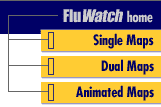Common menu bar links
E-mail this page
Fluwatch
Influenza A & B detections in Canada increasing
During week 08, overall influenza activity in Canada increased slightly from previous weeks with most indicators of influenza activity (except the ILI consultation rate) having increased compared to week 07. Widespread influenza activity was reported by 4 regions (in BC & ON) and localized influenza activity by 13 regions (in BC, AB, SK, MB, ON, QC & NB). Ten regions reported no activity and 29 reported sporadic activity (see map). In week 08, the percentage of specimens that tested positive for influenza was 17% (755/4,518) for Canada as a whole; and regionally ranging from 51% in BC to 0% in PEI. The proportion of influenza B detections in Canada continued to increase over previous weeks, accounting for 37% of detections in week 08; however, the majority of influenza detections were still for influenza A viruses. Regionally, the majority of influenza B detections were reported from AB (see table). This week, the ILI consultation rate declined to 15 ILI consultations per 1,000 patient visits (see ILI graph), which is below the expected range for this week. The sentinel response rate was 56%. Thirty new outbreaks of influenza or ILI were reported this week as follows: 16 LTCFs, 13 schools, and 1 other.
Antigenic Characterization:
The National Microbiology Laboratory (NML) has characterized 504 influenza viruses for the 2007-2008 influenza season: 282 (56%) A(H1N1), 40 (8%) A(H3N2) and 182 (36%) B viruses. All influenza A(H1N1) viruses were antigenically similar to A/Solomon Islands/3/2006. Of the 40 influenza A(H3N2) viruses characterized, 5 (13%) were antigenically similar to A/Wisconsin/67/2005 and 35 (87%) were antigenically similar to A/Brisbane/10/2007. One of the 5 A/Wisconsin-like viruses had reduced titer to A/Wisconsin/67/2005 reference antiserum. Of the 182 influenza B isolates characterized, 3 (2%) were antigenically similar to B/Malaysia/2506/2004 and 179 (98%) were antigenically similar to B/Florida/4/2006 (belonging to the B/Yamagata lineage) (see pie chart).
*** The WHO recommends that the vaccines to be used in the 2008-2009 season (northern hemisphere) contain the following: an A/Brisbane/59/2007 (H1N1)-like virus; an A/Brisbane/10/2007 (H3N2)-like virus; and a B/Florida/4/2006-like virus.
Antiviral Resistance:
Since the start of the season, the NML has tested 343 influenza A isolates (275 H1N1 and 68 H3N2) for amantadine resistance and found that 66 (97.1%) of the 68 H3N2 isolates were resistant to amantadine and 4 (1.5%) of 275 H1N1 isolates were resistant (see recommendation from the 2006-2007 influenza season below).
The NML has also tested 435 influenza isolates (258 A/H1N1, 44 A/H3N2 & 133 B) for oseltamivir (Tamiflu) resistance and found that 33 (12.8%) of the 258 H1N1 isolates tested were resistant to oseltamivir. The resistant isolates were from NL (4), QC (2), ON (15), MB (1), AB (1) and BC (10). These oseltamivir resistant strains remain sensitive to the antiviral amantadine.
Influenza-associated Paediatric Hospitalizations:
In week 08, there were 2 new laboratory-confirmed influenza-associated paediatric hospitalizations (from Quebec) reported through the Immunization Monitoring Program Active (IMPACT) network; both were due to influenza A. Of the 96 hospitalizations reported so far this season, 89% (85/96) have been due to influenza A. The proportion of cases to date by age group are as follows: 19% were 0-5 month olds; 16% were 6-23 month olds; 29% were 2-4 year-olds; 21% were 5-9 year-olds; and 16% were 10-16 year-olds.
*** Due to technical difficulties with IMPACT's electronic reporting system, real-time reports of hospitalizations were not received since early December 2007. Over the next several weeks, more retrospective reports of cases are expected.
International:
CDC: During week 07, influenza activity continued to increase in the United States. Forty nine states reported widespread influenza activity. The proportion of specimens that tested positive for influenza virus increased to 34% this week. Since September 30, 2007, CDC antigenically characterized 280 influenza viruses: 141 influenza A(H1) (124 A/Solomon Islands/3/2006-like and 17 showed somewhat reduced titers with antisera produced against A/Solomon Islands), 70 influenza A(H3) (12 A/Wisconsin/67/2005-like and 55 A/Brisbane/10/2007-like, and 3 showed somewhat reduced titers with antisera produced against A/Wisconsin and A/Brisbane), and 69 influenza B viruses (4 belonging to the B/Victoria and 65 B/Yamagata lineage). Small numbers of influenza viruses resistant to oseltamivir have been detected in the United States, representing 5.7% (27/471) of all influenza viruses tested (8.7% among H1N1 viruses tested).
EISS: In week 08, medium intensity of influenza activity was still observed in 16 countries in Europe however influenza activity passed its peak in most European countries. The proportion of influenza B has further increased from 37% in week 07 to almost 50% in week 08. A number of recent A(H1N1) viruses showed a better antigenic match to A/Brisbane/59/2007(H1N1), the WHO recommended H1N1 virus strain for the 2008-2009 season.
Human Avian Influenza: Since 23 February 2008, the WHO reported 3 additional cases (2 fatal) of H5N1 avian influenza infection from China, Viet Nam and Egypt.
Recommendation for the Use of Amantadine for Treatment and Prevention of Influenza
The Public Health Agency of Canada does not recommend the use of amantadine for treatment or prevention of influenza for the 2006-2007 season. This recommendation will be revisited if new information becomes available.
Total number of influenza tests performed and number of positive tests by province/territory of testing laboratory, Canada, 2007-2008
| Province
of reporting laboratories |
Report
Period: February 17 to February 23, 2008 |
Season
to Date: August 26, 2007 to February 23, 2008 |
||||||
| Total
# Influenza Tests |
# of Positive Tests | Total
# Influenza Tests |
# of Positive Tests | |||||
| Influenza A | Influenza B | Total | Influenza A | Influenza B | Total | |||
| NL | 82 | 8 | 8 | 16 | 513 | 40 | 24 | 64 |
| PE | 17 | 0 | 0 | 0 | 65 | 0 | 3 | 3 |
| NS | 23 | 0 | 3 | 3 | 346 | 4 | 6 | 10 |
| NB | 57 | 7 | 8 | 15 | 447 | 17 | 21 | 38 |
| QC | 1484 | 222 | 49 | 271 | 13488 | 732 | 122 | 854 |
| ON | 1094 | 70 | 33 | 103 | 17591 | 904 | 115 | 1019 |
| MB | 126 | 8 | 4 | 12 | 1854 | 29 | 12 | 41 |
| SK | 288 | 37 | 34 | 71 | 3429 | 164 | 102 | 266 |
| AB | 1166 | 79 | 91 | 170 | 19049 | 533 | 608 | 1141 |
| BC | 181 | 48 | 46 | 94 | 2093 | 377 | 158 | 535 |
| Canada | 4518 | 479 | 276 | 755 | 58875 | 2800 | 1171 | 3971 |
Specimens from NT, YT, and NU are sent to reference laboratories in other provinces.
Note: Cumulative data includes updates to previous weeks; due to reporting delays, the sum of weekly report totals do not add up to cumulative totals.
Abbreviations: Newfoundland/Labrador (NL), Prince Edward Island (PE), New Brunswick (NB), Nova Scotia (NS), Quebec (QC), Ontario (ON), Manitoba (MB), Saskatchewan (SK), Alberta (AB), British Columbia (BC), Yukon (YT), Northwest Territories (NT), Nunavut (NU)
Respiratory virus laboratory detections in Canada, by geographic
regions, are available weekly on the following website:
<http://www.phac-aspc.gc.ca/bid-bmi/dsd-dsm/rvdi-divr/index-eng.php>
Number of influenza surveillance regions† reporting widespread or localized influenza activity, Canada, by report week, 2007-2008 (N=54)

![]()
† sub-regions within the province or territory as defined by the provincial/territorial epidemiologist. Graph may change as late returns come in.
Influenza
Activity Level by Provincial and Territorial |
||||||||||||
|
||||||||||||
Note: Influenza activity levels, as represented on this map, are assigned and reported by Provincial and Territorial Ministries of Health, based on laboratory confirmations, sentinel ILI rates (see graphs and tables) and outbreaks. Please refer to detailed definitions. For areas where no data is reported, late reports from these provinces and territories will appear on the FluWatch website. Select single maps by report week to get this updated information.
<http://dsol-smed.phac-aspc.gc.ca/dsol-smed/fluwatch/fluwatch.phtml?lang=e>
Click on the map to view provinces/territories and maps for other weeks.
Influenza tests reported and percentage of tests positive, Canada, by report week, 2007-2008

Percent positive influenza tests, compared to other respiratory viruses, Canada, by reporting week, 2007-2008
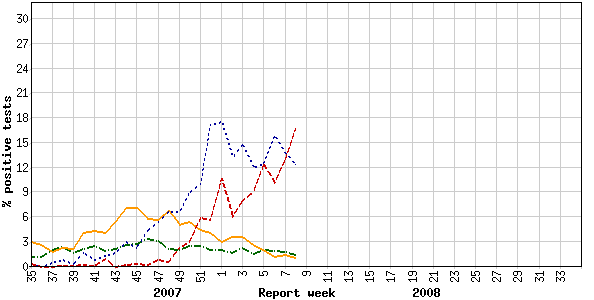
![]()
Influenza strain characterization, Canada, cumulative, 2007-2008 influenza season by the Respiratory Viruses Section at the National Microbiology Laboratory
[N=504]
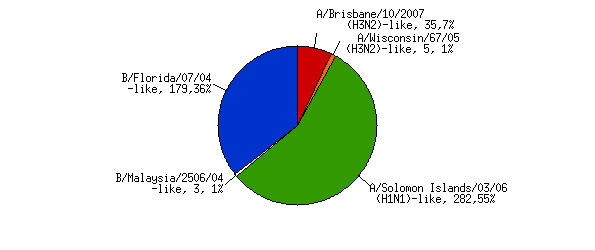
{Strain characterization, number identified, per cent of total number}
NACI recommends that the trivalent vaccine for the 2007-2008 season in Canada contain A/Solomon Islands/3/2006 (H1N1)-like virus; an A/Wisconsin/67/2005 (H3N2)-like virus; and a B/Malaysia/2506/2004-like virus.
Influenza-like illness (ILI) consultation rates, Canada, by report week, 2007-2008 compared to 1996/97 through to 2006/07 seasons
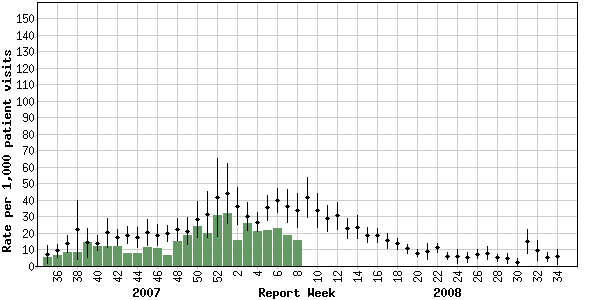
![]()
Note: No data available for mean rate in previous years for weeks 19 to 39 (1996-1997 through 2002-2003 seasons).
Number of New Outbreaks in Long Term Care Facilities, Canada, by Report Week, 2007-2008
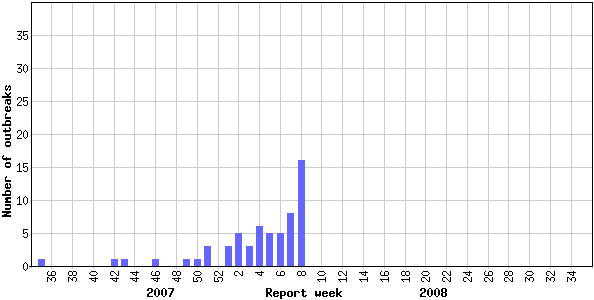
![]()
Please note that the above graphs may change as late returns come in.


